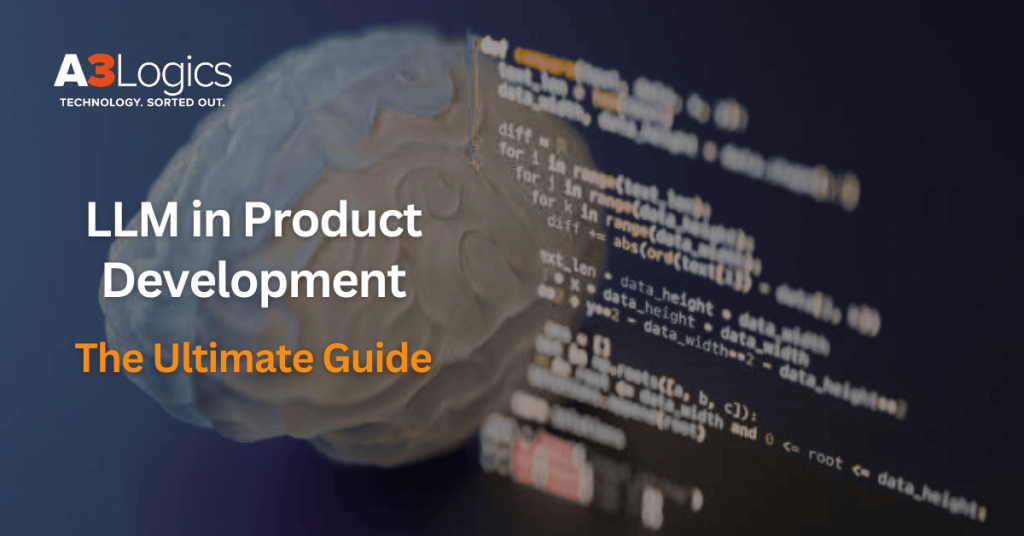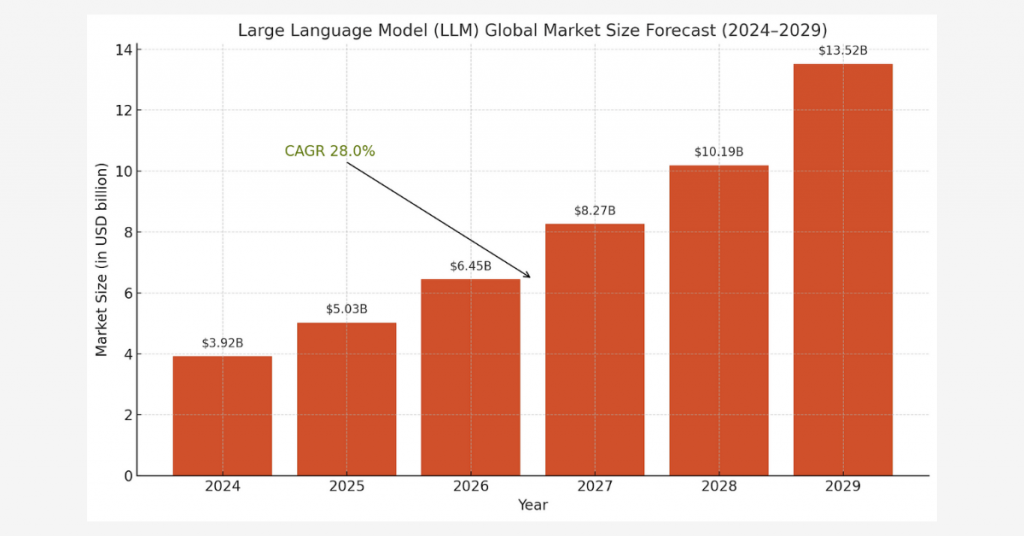The rise of AI has kicked off a whole new chapter in digital innovation. One of the most groundbreaking technologies of our time is LLMs . These incredible systems have moved beyond the confines of research labs and are now making a real difference across various industries by changing the way products are imagined, created, and supported. LLM product development is shifting our work methodology.

Whether it’s brainstorming ideas or analyzing a vast amount of data, large language models are speeding up and helping us make smarter decisions in less time. McKinsey has predicted that generative AI could contribute between $2.6 and $4.4 trillion annually to the global economy, with a big chunk of that coming from research and development, marketing, and product development.

| Source: Business Research Company |
This guide will take you on a thorough and strategic journey into how LLMs play a crucial role in product development. Whether you are a CPO, team leader, or part of a product team, this guide is here to arm you with practical insights into LLM product development and help you stay ahead in the long run.
Table of Contents
What Are Large Language Models and Their Role in Industries?
LLMs are a complex structure of neural networks. They are trained on a large number of datasets. It includes all books, articles, web pages, and even data from platforms like Reddit, Wikipedia, etc. What makes LLMs different is their ability to understand users’ feedback and keep improving based on it. In 2025, many organizations across industries have started using LLMs in their operational processes.
For example, LLMs can create patient reports, schedule appointments with doctors, etc. Large language models in retail create personalized product descriptions at scale, assisting customers to find the right product on ecommerce websites via a chatbot powered by LLM. In finance, it is helping banks to handle account queries, read legal documents, summarize complex financial reports, etc.
A large language model development company can also help you with a custom AI solution. Basically, the LLM models are fine-tuned to specific data for any special use case. This enables businesses to solve niche problems with high accuracy.
PwC reports that 49% of tech leaders have embedded AI into their core product offerings. This makes developing large language models an important and strategic necessity.
Understanding LLM in Product Development
When we talk about LLM product development, we’re looking at how these models play a role throughout the entire product lifecycle. LLMs can help with product research, understanding consumer trends, creating workbooks for engineers, and so on.
1. LLMs as Internal Development Tools
All businesses have operational expenses and require quite an effort. LLMs can help you create tools to streamline processes and save costs. For instance, Codex from OpenAI can help engineers write boilerplate code to reduce the time needed to build software.
2. LLMs as Embedded Product Features
In this scenario, the LLM is part of the product itself. Picture AI-driven writing assistants within SaaS platforms or intelligent help centers that answer customer queries using natural language generation.
Many companies are leveraging LLMs to create requirement documents, simulate user personas, or even prioritize backlogs based on feedback analysis—these are crucial components of a scalable LLM product strategy.
When done right, this approach can significantly speed up timelines and boost team productivity, fundamentally changing how digital products are created.
Top 13 Key Stats for LLMs
LLM product development is skyrocketing. Have a look at the top 30 stats showcasing this growth:
1. LLM Market Growth
The LLM market is expected to grow at a CAGR of 33.2% from $6.4 billion in 2024 to $36.1 billion by 2030.
2. North America Leads in Revenue
Most companies in North America are investing in AI infrastructure. The market is expected to reach $105.5 billion by 2030.
3. Generative AI Investment Boom
According to a report by Gartner, the investment in generative AI is expected to reach $644 billion by 2025.
4. Enterprise Adoption Rate
According to Deloitte, 65% of businesses are using Generative AI tools, double last year’s.
5. Code Generation
Tools like Copilot are helping developers create more than 40% of all code on GitHub.
6. Product Development is Priority
PwC reports say companies are investing more in AI product management to create products that reach the PMF earlier. This is all possible with tools like Loveable.dev, Replit, and CursorAI helping create prototypes fast.
7. Economic Value of Generative AI
McKinsey reports that upto $4.4 trillion can be added to global GDP by generative AI. The product team will benefit greatly from this market growth.
8. Gemini and Claude’s Accuracy
In 2023, Claude 3 Opus got 84.83% average accuracy while Gemini got 80%. This indicates rising competition among foundational models.
9. LLM in Apps
More than 750 million apps have been integrated with LLMs till now. This shows how this technology is embedding so fast in the digital age.
10. Gen Z Driving Adoption
The young generation is using LLMs in their daily routine to improve their knowledge and productivity. Millennials, especially Gen Z are the most hopeful about LLMs.
11. Healthcare Uses Are Expanding
Around 21% of healthcare organizations depend on LLM to handle patient queries. Approx. 18% use LLMs for tasks related to medical research.
12. Education Boost
Students are using LLMs to answer their curiosity. Many apps are using LLMs that provide custom quizzes and tests. This has shown a 62% improvement in their academics.
13. Grok-1 Emergence
Elon Musk’s xAI launched Grok-2 in 2024. Grok-1 remains the largest open source LLM with 314 billion parameters.
The growing stats above show the rapid growth of LLMs. This is a huge opportunity for companies to partner with an AI development company and deploy LLM based apps. The early adopters will have the first mover advantage and will redefine what’s possible.
Use Cases of LLM Product Development

Integrating LLM in product development is not a one-directional upgrade. It improves all parts of the product lifecycle. It adds intelligence, faster deployment, and much more. LLMs are powerful when integrated correctly into the workflows.
There are many use cases where LLM product development is driving measurable impacts. Let’s break down each:
1. Market Research
Every product building starts with product research. It involves understanding the market and the right users. Before LLMs, the research was done through intensive surveys, time-consuming interviews, and reviews. The process would also include analyzing competitors. The overall process is not just time-consuming but very overwhelming.
But now with LLM, research can be done in minutes. Features like deep research from OpenAI with advanced reasoning models o3 and o4-mini can give results like no survey can ever provide. LLMs break down tons of data into very structured content in minutes and answer queries very specifically.
Applications:
- LLMs can scan through thousands of surveys and many web pages, highlighting common challenges or feature requirements.
- Identify gaps in the UI and UX of competitors, so that you can build a better UX strategy.
- Create a market opportunity report by analyzing the entire industry and connecting the dots to reach a conclusion.
2. Product Design and Specifications
Once the research is done, the next step is to turn insights into actionable design. Writing product requirement documents (PRDs) and aligning engineers and stakeholders can take weeks. LLMs can reduce this time by automating and enhancing the process.
Applications:
- Create PRDs with the help of user stories or prompts.
- Analyze existing spec documents to find errors and fix them, all via prompting.
- You can suggest potential failure points based on historical or known bugs.
3. Content Generation
LLMs in content creation can be used for marketing collaterals like blogs, newsletters, ad copy, and social media posts. The content can be in image, text, or even video form. OpenAI’s ChatGPT 4o can produce images and texts with just simple prompting.
Applications:
- Create content with different tonalities, set the content’s difficulty level, like middle school or graduate, to create content for a specific target audience.
- Create images with the GPT-4o model. The model can also help you create memes, simple infographics, and more.
- Create long-form content like blogs, product guidelines, brand strategy doc, etc.
4. Code Generation and Software Development
One of the most valuable and practical use cases is the code creation. These LLMs become coding partners, helping developers write code better and faster. It can help autocomplete logic, improve syntax, and even create entire test suites.
Applications:
- Auto-completing data transformation functions just by input infrastructure.
- Suggest improvements in performance or refactoring options
- Recommending performance improvements or refactoring options
- Auto-generating unit and tests based on acceptance criteria.
This is leading to a foundational change in how we build products. LLM product development is the next new phase of the coding era, which will substantially increase developers’ productivity.
5. Customer Support and Feedback Analysis
The customer support system has always been very hectic and inefficient. There are always high ticket volumes to handle. Large language models can significantly solve customer support issues. LLMs can reduce ticket volume while enhancing customer satisfaction.
Applications:
- Models trained on customer support docs can solve queries 24/7.
- Turn customer feedback into actionable insights to improve product quality.
- Detecting patterns in customer complaints and suggesting improvements before problems get bigger.
6. Regulatory Compliance & Documentation
Creating documents for certifications, audits, and governance requires intense work and focus. In sectors like healthcare and finance, product building requires strict compliance. This is where LLMs can create magic, automating the generation of policies, documents, NDAs, etc. It can save time, labour costs, and also reduce errors.
Applications:
- Create technical docs aligned with ISO/IEC or FDA formats.
- Creating doc templates for HIPAA and GDPR compliance.
- Turing legal and tech jargon into plain language for the team and stakeholders to understand.
Example:
Here we can understand this use case better by taking an example of a medtech startup. They used LLM to create a wearable gadget’s Software Requirements Specification (SRS).
The product team created risk mitigations and data privacy policies with simple prompts. Then, a compliance officer reviewed the output. The process saved 40+ hours in preparation time and saved labour costs. LLMs also help create traceability matrices, translating user requirements into technical implementation.
Companies can partner with a generative AI development company to ensure LLM outputs meet the audit standard while preserving data integrity.
How to Implement LLM Product Development Workflow
Implementing LLMs requires a structured approach. Here is a step-by-step framework product teams can follow:
1. Pinpoint High-Impact Use Cases
Identify use cases where LLMs can bring the most value. They should be:
- Heavy on writing or summarizing
- Too much data and research
- Repetitive like PRD, test cases
- High Customer-facing
Do discovery sessions with team members from design, support, and product to map pain points. This helps you get validation for investment in LLM Development.
2. Select the Right LLM Setup
Check everything that needs to be included and excluded in the product scope. Consider the sensitivity and scale of your product, you might choose:
- Pre-trained APIs (like GPT-4o of OpenAI, Claude by Anthropic)
- Fine-tuned custom models based on your datasets
- Open-source large language models like LLaMA or Mistral
Consulting with a large language model development company is highly recommended. Selecting a right one among best large language models is very crucial, considering security and high initial costs.
3. Start Small With Prototypes
Many no-code tools help you create small prototypes or auto-generate PRD. Set clear KPIs, such as:
- Time saved on each task
- Quality scores from team reviewers
- Reduction in backlogs or turnaround time
This is a great opportunity to refine and modify product features based on customer feedback.
4. Integrate Into Existing Tool
Integrate LLM into the workflows on the platforms your team is already using. Tool like:
- Slack or Zoom bots for quick summarization
- Notion integration to create docs
- Visual Studio Code extensions for developer productivity
Seamless integration increases adaptability, without making any unnecessary disruption.
5. Build Strong Governance and Monitoring
As your LLM product scales, make sure you have guardrails in place. Create processes for:
- Validating outputs
- Regularly auditing prompts
- Following AI ethics guidelines
Use dashboards to track and monitor LLM usage, behavior, errors, and performance. Always build a mechanism to return to manual workflows if the model fails to meet expected criteria.
6. Training Your Team
The most important factor is to train your team members, especially the product owner, designers, and engineers. Consider:
- Write better prompts
- Learning to Fine-tune LLM outputs
- Understanding LLM limitations like hallucinations, outdated data
Encourage an ecosystem of learning and experimenting with AI and LLMs. Educate the team to develop mindsets to see LLM as a collaborator, not a replacement.
Future of LLM in Product Development
1. Domain-Specific LLMs
Companies are opting for vertical AI models. For example: LLM for Radiology in healthcare, Legal document drafting, etc. These trained models outperform generic models out there. Partnering with an AI development company to create models for a specific domain is highly recommended.
2. Embed AI in Products
LLMs are not just in the backend, but are also becoming a central differentiation for tech brands. From chatbots to summarization tools, LLM development is the new core of modern product development.
3. Regulation and Ethics
There is a solid need for governance to regulate AI. Governments worldwide are already drafting laws and policies. These rules are around the model transparency and user consent. Companies that build ethical usage guidelines and ensure traceability will build more trust with users and stakeholders.
Conclusion
The future of product development is smart, AI-driven, and fast, powered by LLM.
Companies like Microsoft and Salesforce are already ahead in embedding LLM into their core systems. The competition is on the rise. Those who are not taking risks now will fall behind.
We at A3Logics have worked on over 500 projects in the last 20 years. Our goal is to build LLM products that can create huge value for your customers. If you want to bring your ideas to life with the power of LLM, you are at the right place and right time.
Contact us today and let’s discuss what we can build together for the world!







